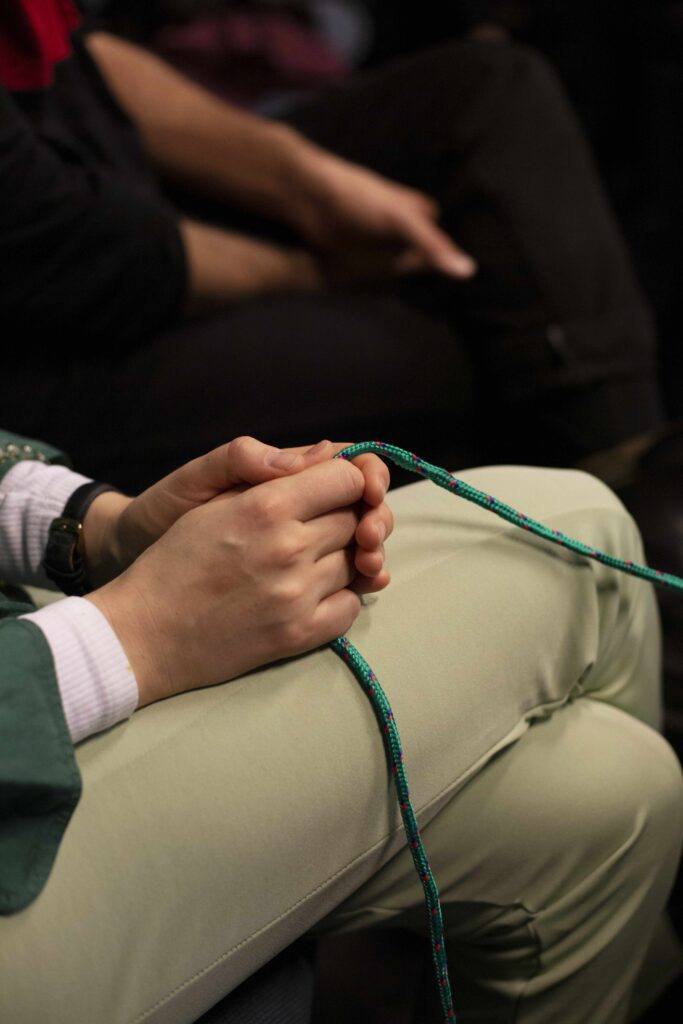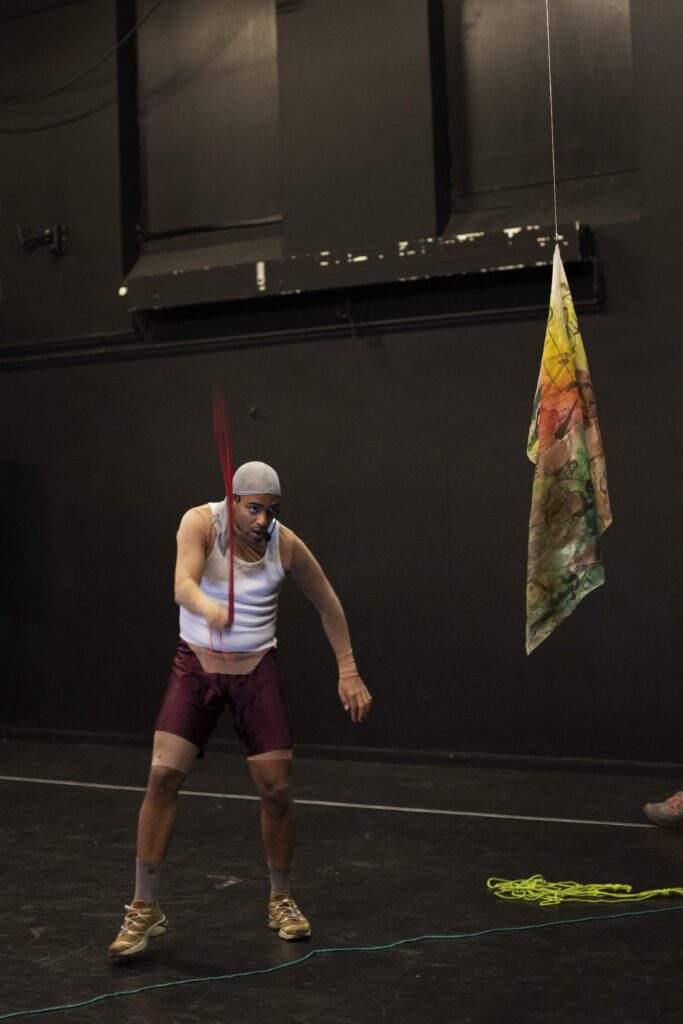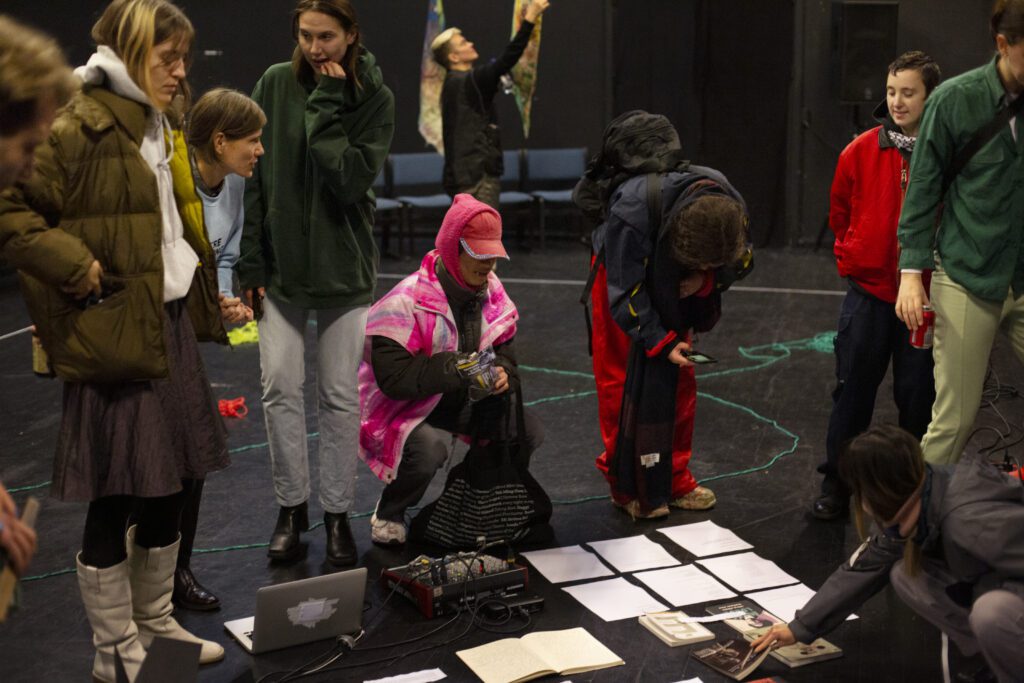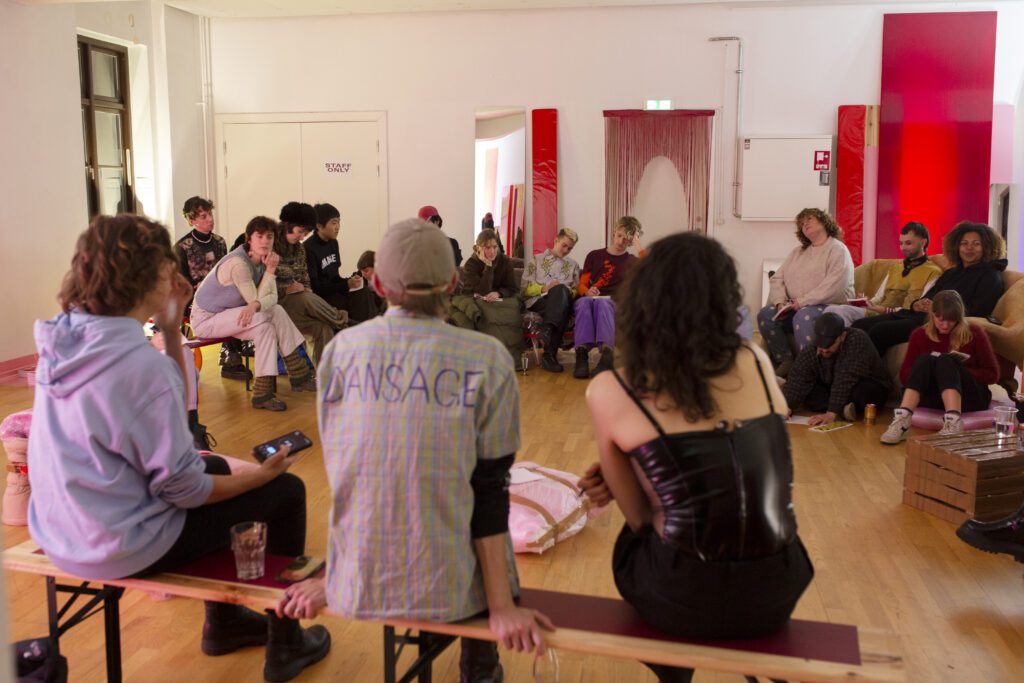HAUT ‘s YC festival ran from November 23rd-25th and invited the audience to experience artistic works in process and interventions up close, dive into conversations, join workshops and collective meals, as well as two international guest performances. Filip Vest relates their experience of two works in process, Black is a verb but only on earth and Surbending, one performance about blue eyes and one about a blue pill, one about imagining a home and one about surrendering to noise.
This text is a part of the collaboration between HAUT and bastard.blog. A collaboration where they try to find new ways of documenting artistic research and work methods.
Black is a verb but only on earth
During a one-week residency prior to YC Festival, the artist and writer Sandy Harry Ceesay (they/them) explored the power of the imaginary in relation to their own lived experience of being a part of the West African diaspora and the queer community. At the festival we got to experience an embodiment of this research through the work sharing Black is a verb but only on earth.
Before we enter the performance space, we are instructed to feel free to walk around, read the texts and touch the installation in the room. In one corner of the stage a variety of books and texts by Toni Morrison, Édouard Glissant, Audre Lorde and other authors are spread on the floor. In the other end of the space two silk scarfs are hanging from the ceiling. In the middle are three colored ropes lying on the floor.
As an introduction to the performance, Ceesay talks about how to give context to a performance inside this very isolated room, that the theatre space is and how to bring the work closer to the world. They then go on to read a poem by a Palestinian poet, before calling for a ceasefire in Palestine as well as other genocides currently happening in Congo and Sudan.
Ceesay is wearing a durag on their head, training shorts and a brown skintight mesh top giving an illusion of nudity. They start playing around with one of the ropes. They give one end of the rope to a member of the audience. Then they put a rope in their mouth and walk around on all fours like a dog. Back on two legs again, Ceesay starts breathing loudly into the headset mic, making a scratchy noise. The heavy breathing turns into a form of beat as Ceesay paces back and forth in the space. They give one end of another rope to another person in the audience. Then a voice starts talking from one of the speakers. “What if I had blue eyes?” the voice asks, echoing Toni Morrison’s novel The Bluest Eye about the young African American girl Pecola who turns mad with a desire to have blue eyes as an emblem of whiteness and her way of getting accepted and regarded as beautiful. “Be someone else, you can be anybody,” the voice in the speaker naïvely declares. Ceesay replies and has a dialogue with the voice coming from the speaker.
“Me? Why?”
“Yes, you!”
“Blue eyes?”
“Yes…”
The dialogue turns into a form of song or poem, repeating the same phrases again and again, “What if I had blue eyes?” Ceesay asks. “Blue eyes?” … “Me?” … “What if I had blue eyes?”. They tongue pop and start dancing around the space. All the time there is playfulness parallel to a feeling of grief. Ceesay is playing with us, with how they are perceived, with naïvity and seriousness. They transform the rope into different images. One moment they are walking around with an invisible dog on a leash, going “Tss, tsss, tsss” at the dog, the next they’re using the rope as a skipping rose. There is a restless energy in the performance. The performance is happening and yet it somehow feels like it hasn’t begun yet. Ceesay is moving between different tasks, as if trying out different strategies for communicating something.


“I’m trying to tell the story, but a lot of things are in the way,” they say before another voice starts telling a story from the speakers. While we hear the story Ceesay dances around in the space. “You enter into the house in which you are not welcome,” the voice goes. The story revolves around the idea of ‘home’. How can you make something into a home? What does the idea of home mean to someone who is constantly in transit? Can a rucksack be a home?
Now Ceesay turns the rope into a whip and starts whipping themself. “Tell me your happiest childhood memory,” the voice from the speaker says, contrasting the violent imagery being portrayed on stage. “Let me tell you a story,” the voice says, as Ceesay keeps whipping themself. “Somewhere to call home, where you don’t have to walk anymore…”
“I’m there for you,” the voice says before ironically going silent. Then Ceesay leaves the space and we’re abandoned in the same way as they were just abandoned by the voice. Left to figure out for ourselves how the story continues, when the restlessness will end, when and how a story will be able to become a home.

Black is a verb but only on Earth is a conglomerate of Black and queer imagery tying together multiple references, playing with tropes, making up new images, fluctuating between violence and humor, sincerity, and irony. It is a work that is concerned with movement and images, but also the importance of words: as tools for worldbuilding, as ways of framing history backwards, as materials for new histories, herstories, stories, poems, and homes.
Black is not only an adjective and noun, it is also a verb. It is something that is created, that is actively negotiated and reimagined. Like history, or a home, it is something we cannot take for granted, but that we have to make together. Black is a verb but only on Earth is imagining a home with its audience, sketching the first lines, and trying to see if it is inhabitable, and what stories can be told from here.
Surbending
The worksharing of Surbending is the result of a one week IN PROCESS residency leading up to the festival. During the residency choreographer and dancer Andreas Haglund (he/they) and composer and programmer August Norborg / FASCIA (she/her) used motion tracking webcams to make sound and movement interact and explore ideas about agency, autonomy, queer health and “surrendering as a tool of subversion”.

As we enter, August Norborg is standing behind a table with her computer setup, while Andreas Haglund is moving around the space in an oversize white silk bomber jacket and a top with a spiral pattern. Noise music is coming out from the speakers. There is an eerie atmosphere. A distorted voice says something unintelligible. As the music changes and turns more rhythmical, Haglund starts walking around in big circles in the space. Haglund accelerates. They’re now running. There is something hypnotic about the repetitive movement and the music with its low-pass frequencies, noises, and weird modulations. Haglund starts pulling something invisible with his hands as they’re dancing back and forth. Norborg moves a motion tracking camera from behind the stage in front of Haglund. The music stops and from the speakers a poem is now being read aloud. “Pushed, pulled, penetrated, policed, patient, pegged …” the voice goes, as Haglund moves in front of the camera and distorts the sound with their movements. The poem talks about swallowing a blue pill, a reference to PrEP, the medicine that you can get prescribed as a queer person to prevent contracting HIV from sex. The sound of the voice starts mixing with bodily sounds: munching, slurping, swallowing. It feels like being underwater, or maybe being a small blue pill moving through the digestive tract, before being shuttled via a blood vessel to the liver.
Listening to the text I’m reminded of the speculative writings of queer philosopher Paul B. Preciado. In his essay ‘Chemical Condoms’ (published in the collection ‘An Apartment on Uranus’, 2019), Preciado compares the PrEP pills to a form of queer birth control: “Truvada, like the pill, marks the transition from a sexuality controlled by ‘hard’ external disciplinary apparatuses (segregated buildings, architectures designed for locking people up, chastity belts, condoms, etc.) towards a sexuality mediatized by pharmacopornographic systems, that is, by ‘soft’, biomolecular and digital technologies. Contemporary sexuality is constructed from molecules commercialized by the pharmacological industry and immaterial pornographic representations circulating in social networks and the media. (…) Truvada is neither a simple medication nor a vaccine (it cures nothing, prevents nothing in a single dose); rather like the contraceptive pill, it is a biopolitical machine: a biochemical device that, although applied to an individual body, ultimately operates on the totality of the social body, producing new forms of relationship, desire and affect.”

It is this biopolitical machinery and mess that Surbending writes itself into, as Haglund’s body bends around in front of the camera and Norborg tweaks the programming of the music, each trying to manipulate this rigid network, that they have been placed/placed themselves within. Haglund is now on all fours moving backwards like an animal. “My biopolitical daddy,” the poem reads and makes me think of what it means to navigate within a system where you have to perform a certain sexuality (and promiscuity) to receive a blue pill from the state or where you have to make your gender dysphoria legible within a binary framework to receive your hormones from “daddy”. “My daddy is not like everybody’s daddy,” the poem continues. A loud beep emits from the speaker and the music intensifies. Norborg starts manipulating the music with a lamp. Haglund picks up a small speaker as the sound moves from the big speakers into the small one. He rolls around on the floor, shaking together with the speaker. Haglund then gets up and starts swinging the speaker in one hand, making it hover dangerously close to the audience. In the end the performance almost turns into a rave as Haglund stomps faster and faster on the ground, while moving closer to the camera and keeping intense eye contact with Norborg. Haglund’s movements and the music accelerates as it becomes unclear who’s controlling who. Is it the speed of the movements controlling the speed of the music or vice versa? Who’s reacting and who’s causing? Who’s in control? And what would happen if the body stopped moving to the beat and started surrendering to the noise? If it became ineligible, untranslatable? If it escaped the beat and the binary?
What would happen if the body just became noise?
I bet daddy wouldn’t like that…
